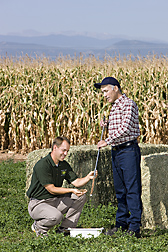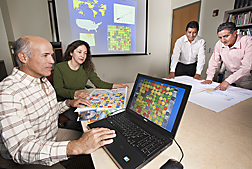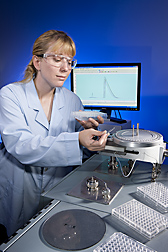Tools To Help Make Decisions for Better Nitrogen Use
Jorge Delgado is an expert in a very complicated field: the use of nitrogen-based fertilizers. How much fertilizer should be applied to the soil, when in a growing season to apply it, and what alternatives might work best are complex issues. “The right approach will vary from one location to the next and from one crop to the next, and it will also depend on a grower’s management practices,” says Delgado, an Agricultural Research Service soil scientist with the Soil Plant Nutrient Research Unit (SPNRU) in Fort Collins, Colorado.
The issue is critical because nitrogen-based fertilizers are a major reason why agriculture is a significant source of both greenhouse gas emissions and the pollution in waterways and estuaries that causes hypoxia. If growers apply too little fertilizer, it reduces crop yields. If they apply too much, the excess can be released into the atmosphere as nitrous oxide or may leach into the water as nitrate. Add in the nitrogen produced by animal waste, and it is easy to see why reducing nitrogen losses to the environment is a major goal in agriculture today.
“Nitrogen is intimately linked to water quality issues throughout the United States, particularly when you think of estuaries like the Gulf of Mexico and Chesapeake Bay. So any technique or tool that will help reduce the amounts of nitrogen going into our waterways will be of benefit,” says Mark Walbridge, ARS national program leader for water availability and watershed management.
Nitrogen-based fertilizers are a necessity for high crop yields and global food security, but growers need to minimize the environmental aspects of using them. Delgado is helping growers, conservationists, and others determine how much nitrogen to apply to a field by fine tuning and promoting two ARS-developed tools, the Nitrogen Index and the Nitrogen Loss and Environmental Assessment Package (NLEAP). Both will analyze how much nitrogen is being used and lost from a field—a first step in finding better alternatives.
For the Nitrogen Index, nutrient managers use information that can be obtained in one visit to a farm,such as the crop being raised, the projected yield, whether irrigation is provided, and whether cover crops are used. This allows a quick assessment of the risk of environmental impact under current and alternative management practices.
NLEAP is a computer model that uses Geographic Information Systems data from a site, and it takes more time and skill to use. Details such as soil particle size, soil nitrogen content, rainfall amounts, and weather patterns are required. These tools have been distributed to hundreds of users, including farmers, agribusinesses, scientists, extension agents, state and federal agencies, and international users.
In addition to NLEAP and the Nitrogen Index, Delgado has helped develop a tool designed for fledgling “environmental trading” credit programs that reward growers for reducing nitrogen losses. Known as the “Nitrogen Trading Tool” (NTT), it can determine how much a given management practice may reduce nitrogen losses and thus how much trading credit could be earned by switching to that practice. The concept of trading nitrogen credits to clean up waterways is in its early stages, but efforts have begun in Pennsylvania and Ohio, with municipalities and state environmental agencies in several states and watersheds studying the concept.
|
|
Getting the Word Out
Delgado spends much of his time tailoring the tools to the needs of growers throughout the United States and in overseas projects funded by the USDA Foreign Agricultural Service and the U.S Agency for International Development. He has also published a book on nitrogen management techniques with Ron Follett, SPNRU research leader, and has posted a link to an Internet site (ars.usda.gov/npa/spnr/nitrogentools) that allows users to download the Nitrogen Index and NLEAP and instructions on how to use these tools.
In recent years, Delgado has advised scientists, helping them calibrate NLEAP and the Nitrogen Index to assess the efficiency of nitrogen use in several states as well as in Argentina, Bolivia, Ecuador, Mexico, and Spain. He has also conducted nitrogen management research in cooperation with scientists from China, Switzerland, and other countries. He has worked with scientists at the USDA Natural Resources Conservation Service (NRCS) to develop a Nitrogen Index prototype that was found to be effective by scientists, growers, professors, extension agents, and conservationists in the United States and internationally. Delgado has also worked with scientists at the University of Puerto Rico at Mayagüez and NRCS to adapt the Nitrogen Index to the unique soil and climatic conditions of the Caribbean basin.
“His research has a long history of resulting in positive contributions and new technologies that can help us assess and manage nitrogen strategies in very different soils and geographic areas. His advice on the development of new concepts such as NTT has also been incredibly useful,” says Shaun McKinney, an NRCS scientist in Oregon.
Delgado published details of his efforts to reduce nitrogen losses from corn and dairy farms in Mexico in the peer-reviewed journal Terra Latinoamerica. He has also published a peer-reviewed report in Advances in Agronomy that showed how NTT could be used to calculate the potential for nitrogen trading for different management practices in a Virginia no-till operation, an Ohio farm where manure is applied to grow corn and soybeans, and irrigated barley and potato fields in Colorado.
Effective at Selling Alternative Practices
The tools have also helped convince growers of the need to improve their soil-management practices by using conservation tillage, crop rotation, and cover crops such as wheat, rye, and other grasses. Such practices not only help keep nitrogen in the soil and prevent nitrates from leaching into waterways, but they also help prevent soils from eroding and keep carbon and nutrients sequestered in the soil.
The environmental benefits can be significant. In Colorado’s San Luis Valley, where Delgado has worked for years, the tools have been useful in assessing the potential of reducing nitrogen fertilizer inputs by using cover crops in potato and vegetable fields. The switch has saved thousands of tons of topsoil each year that would otherwise be lost to erosion. Keith Holland, a valley grower, credits Delgado with steering him toward the use of cover crops on the 700-acre farm that he shares with his brother. With Delgado’s guidance several years ago, Holland began using sorghum-sudangrass, a popular hybrid cover crop, and he has since been using less fertilizer, increased the yields from his barley and potato fields, and seen improvements in soil quality. The quality of his Russet potatoes, grown for fresh-market sale, has also improved. “They’re bigger potatoes, and they’re more uniform in size and shape,” Holland says.—By Dennis O'Brien, Agricultural Research Service Information Staff.
This research is part of Climate Change, Soils, and Emissions, an ARS national program (#212) described at www.nps.ars.usda.gov.
Jorge A. Delgado is in the USDA-ARS Soil Plant Nutrient Research Unit, 2150 Centre Ave., Bldg. D, Fort Collins, CO 80526-8119; (970) 492-7260.
"Tools To Help Make Decisions for Better Nitrogen Use" was published in the September 2011 issue of Agricultural Research magazine.









